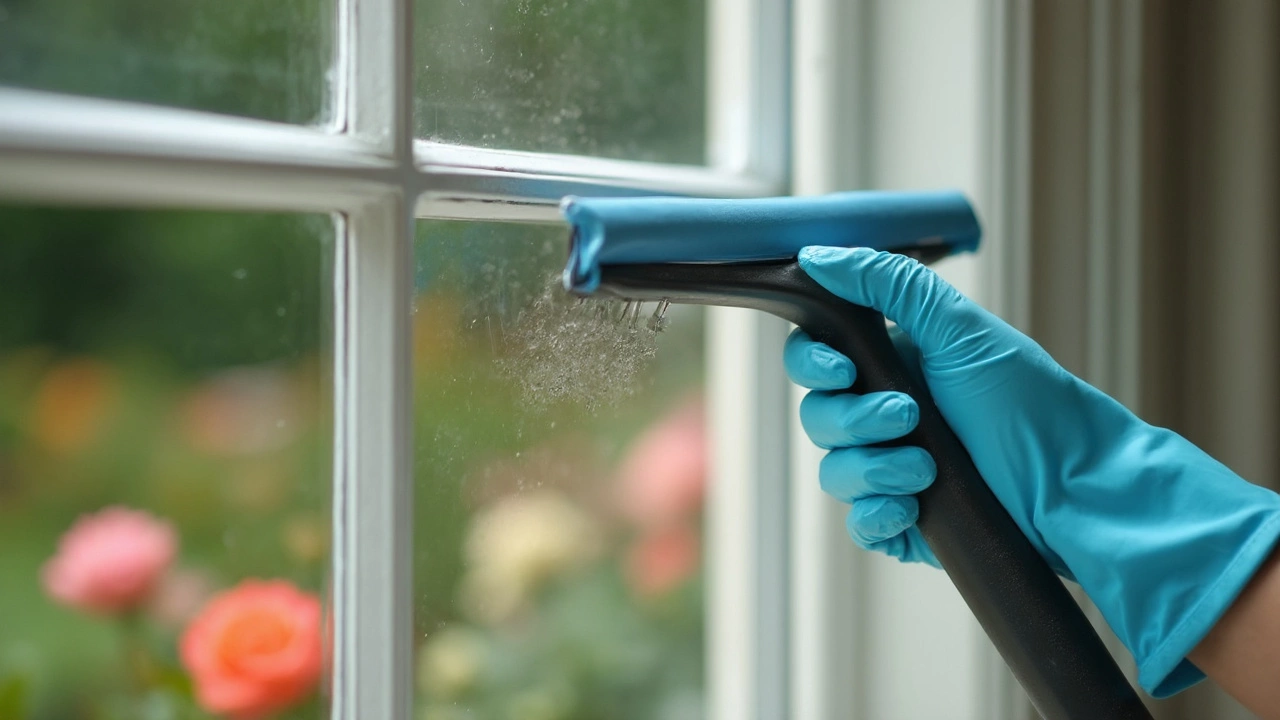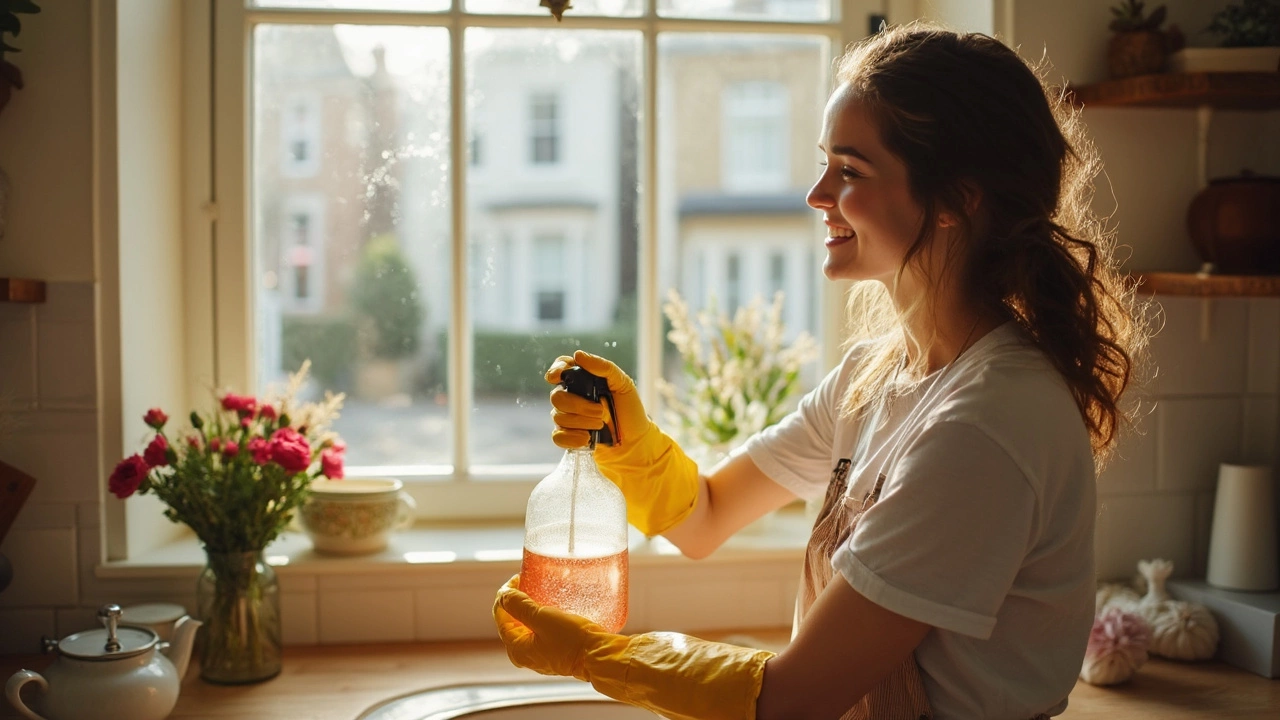Ever wonder why pro cleaners knock out sparkling windows in half the time it takes the rest of us? Most of us dread window cleaning because streaks always show up, and somehow those grime smudges just smear from corner to corner. Your neighbor’s windows are gleaming, but yours still show last week’s dog nose art and mystery fingerprints. The joke? You don’t need fancy gadgets or expensive sprays—just the right method, a dash of science, and a quick kitchen hack.
The Science Behind Spotless Windows
Here’s a wild fact: the reason windows are tough to clean isn’t just because of dirt. It’s science. Glass looks smooth, but if you viewed it under a microscope, you’d see it’s full of teeny dips and peaks. Dust, grease, and pollen work their way in there. If you spray, wipe, and rush, you just smear the grime around and leave streaks as the cleaner dries unevenly. According to a research project at Penn State, most supermarket window sprays leave behind detergent residues that attract more dust and moisture, so you’re sometimes making things worse, not better!
Temperature plays a role too. On a hot sunny day, the liquid in your cleaner evaporates super fast, leaving behind mineral traces and streaks. That’s why pro window washers pick cool, cloudy mornings for the job. Water quality is another big one. Hard tap water leaves behind calcium and magnesium marks—you might notice these as milky deposits or almost rainbowy stains, especially after a rainstorm or hose spray. That’s one reason distilled water is a secret pro weapon: no dissolved minerals, no spots.
Here’s something not everyone knows—microfiber cloths aren’t just for show. Their tiny synthetic fibers grab onto dirt and trap it, rather than just moving it around like paper towels. So, whether you’re cleaning car windshields, home skylights, or those giant windows in your living room, the battle is against streaks, smears, and spotty residue, all rooted in some surprising chemistry.
And about vinegar—grandmas didn’t get this wrong. A 50/50 mix of white vinegar and water cuts through greasy, sticky, and dried-on dirt like magic, all without leaving a soapy film behind. The only downside? Your house might briefly smell like a salad. But given that commercial sprays can trigger headaches for some people, vinegar’s a safe bet, especially around kids and pets.
The Foolproof Window Cleaning Method
I’ve tried every hack that’s been shared at backyard barbecues and school pick-up lines. Want the one real trick for window cleaning that leaves glass crystal clear? It boils down to three things: the right cleaner, a squeegee, and the right motions. Here’s the drill that every professional I’ve spoken with swears by:
- Use a bucket filled with warm water, a few drops of dish soap, and, if your windows are caked with grime, a splash of white vinegar. If you’ve got hard water, swap tap for distilled water. Seriously, it makes a big difference.
- Skip the spray bottles for big jobs. Dunk a soft, clean sponge or cloth in the soapy water and wash the window, getting into every corner (don’t forget the frames and sills—no one likes streaks on a dirty border).
- Now, grab your squeegee. Work from the top of the window down in straight horizontal strokes for wide windows, or vertical for tall windows. Start at one side and slightly overlap your strokes, wiping the squeegee blade with a microfiber cloth after each pass—this step is everything for avoiding streaks.
- If you miss a spot, don’t go over it with the old, dirty rag. Use a new corner of your microfiber. One dirty swipe and it’s smudge city.
- Finish up by wiping the edges with a dry microfiber or clean, lint-free towel. That keeps any drips or excess moisture from leaving runs. And yes, go over the tracks while you’re at it. Gunk here attracts bugs and mold.
Ever see old newspaper recommended for drying? It can work for small windows, but watch out: newsprint ink can transfer onto your hands and window frames if you’re not careful. Honestly, modern microfibers work better without the inky mess.
If you’re feeling ambitious, check for glass scratches or mineral stains. For fine scratches, toothpaste works as a DIY polish—just rub it gently and rinse—but deep scratches need a pro’s hand.

Homemade Cleaners That Actually Work
Store shelves are crowded with sprays claiming “no streaks” and “crystal shine.” Problem is, most commercial glass cleaners are a mix of water, alcohol, and detergents that can leave residue behind. Plus, the strong artificial scent isn’t for everyone. Making your own cleaner isn’t just cheaper; it’s healthier for you and the planet. Here are a few recipes anyone can whip up in two minutes or less:
- Classic Vinegar Mix: Combine equal parts distilled white vinegar and water. If your glass is super grimy, add a drop of dish soap to help break down grease.
- Lemon Fresh: Mix 2 tablespoons lemon juice with 2 cups water. The citric acid works like vinegar to break down sticky fingerprints and hard water deposits, plus your house smells fresh.
- Tea Tonic: Brew a strong black tea and let it cool. Tannins in tea cut through grease and dirt on windows (really!). Pour into a spray bottle and use as you would any glass cleaner—bonus if you like the subtle scent.
Thinking about using ammonia? It cleans well, but the fumes can be harsh. If you do, always crack a window and keep kids or pets away until the glass is dry. Never mix ammonia with bleach or anything acidic like vinegar—the combo produces dangerous fumes.
A good tip: label your homemade cleaners, and secure the bottle lids well. Vinegar and tea left in a humid spot could attract fruit flies or just go weird, fast.
If you’re tackling exterior windows up high, attach your sponge or squeegee to a telescoping pole. No need to risk your neck on a wobbly ladder. And if birds keep streaking your glass, a few decals or hanging shapes on the outside will scare them off without ruining your view.
Speedy Solutions and Pro Tips
You don’t have to block off a whole Saturday for this. Here’s how to keep windows gleaming, fast:
- Clean windows twice a year—spring and fall are perfect. More if you’re near the ocean or have lots of pollen or dust storms.
- Always clean from top to bottom so dirty water doesn’t run onto spots you’ve cleaned. This sounds obvious but is the number one mistake most people make.
- If you’re dusting blinds or curtains, do it before you clean the glass. Otherwise, dust particles just settle back onto your finished windows.
- Wipe in different directions inside and outside—horizontal on the inside, vertical on the outside. That way, if you spot a streak, you know where it’s hiding.
- Got stubborn spots like bird droppings or sticky sap? Loosen them first with a bit of warm, soapy water, then tackle them with your squeegee.
- If you find old paint flecks or sticker residue, gently use a plastic scraper at a steep angle. Don’t use razor blades unless you know what you’re doing—modern glass can scratch easily.
Here’s a quick stats table you might find handy about window dirt sources and cleaner effectiveness—from a university study published in 2024:
| Dirt Source | Frequency (%) | Effectiveness of Vinegar Cleaner |
|---|---|---|
| Pollen | 40 | Excellent |
| Pet Nose/Handprints | 25 | Good |
| Water Spots | 20 | Fair |
| Insect Marks | 10 | Good |
| Smoke/Grease | 5 | Excellent |
One last game-changing tip: Don’t stress perfection. Light coming through a clean window always looks better, even if one or two little streaks slip by. The right tools, cleaner, and a couple of pro moves will get you 99% of the way there, every single time. Now, if only the rest of the house were this easy to get spotless!
